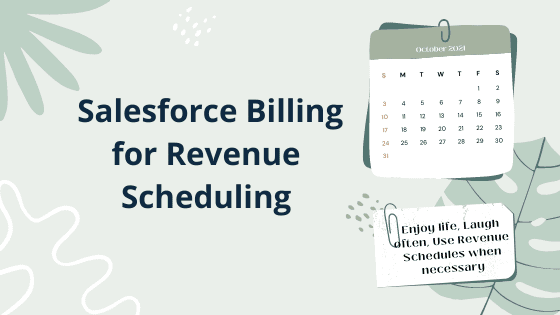When to use Salesforce Billing to create Revenue Schedules
When deciding whether to recognize revenue from order products, consider key business needs regarding how your company uses revenue information in Salesforce Billing. For example, it’s important to know whether you’ll use Salesforce Billing for revenue forecasting or as the system of record to meet revenue recognition guidelines.
| BUSINESS NEED | SHOULD I RECOGNIZE REVENUE FROM THE ORDER PRODUCT? |
|---|---|
| I need to monitor my revenue cycle to predict future revenue trends and act on them. | Yes |
| The pricing for this product is one-time or subscription based, and I need to see the revenue it generates ahead of time. | Yes |
| The pricing for this product relies on usage, and I need to see the revenue it generates actively, rather than for predictive purposes. | No |
| I need to consolidate revenue for amendments together with revenue from the original deal. | No |
Full Recognition from Order Products
- To recognize revenue on the order product in full, apply a rule with an order-based, full-recognition revenue distribution method to the Product. Salesforce Billing generates a revenue schedule upon order activation. The revenue schedule contains one revenue transaction for the order product’s full amount. The revenue schedule also sets its Full Recognition Date field based on the revenue distribution method’s settings — either the invoice line start date or end date.
Pro Rata or Ratable Recognition for Order Products
- Forecast revenue pro rata by applying an order-based, ratable revenue recognition rule to the product. Salesforce Billing still creates the revenue schedule upon activation, but it has several revenue transactions instead of one. The number of transactions varies based on the order product’s start and end dates, and the Distribution Method field on the revenue distribution method.
Recognize Revenue from Order Products with Multiple Revenue Obligations
- Sometimes, a product has both flat fee and ratable revenue obligations. You can handle this by using multiple treatments on your revenue recognition rule. For example, you could make a rule which recognizes 20% of an order product line ratably and 80% up front.
Recognize Revenue from Order Products on Amendment
- On amendments, the same revenue recognition rule applies to both the original order product and the amendment order product. Salesforce Billing creates a revenue schedule for the amendment order product based off its effective quantity. If the amendment is a reduction or cancellation, the resulting revenue schedule has a negative value to reconcile the revenue difference.
Get the whole scoop around Salesforce Billing by visiting Salesforce Help Docs found here: Manage Your Billing Processes with Salesforce Billing

